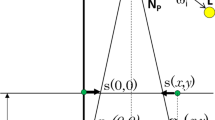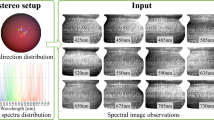Abstract
In this paper, a novel technique, called the photogeometric technique, is presented for surface reflectance extraction and surface recovery from an image sequence of a rotating object illuminated under a collinear light source (where the illuminant direction of the light source lies on or near the viewing direction of the camera). The rotation of the object is precisely controlled. The object surface is assumed to be smooth and uniform. The technique first computes the 3D locations of some surface points which give singular brightness values and builds the surface reflectance function by extracting the brightness values of these surface points from the image sequence. Then the technique uses the surface reflectance function and two images of the surface to recover surface depth and orientation simultaneously. The technique has been tested on real images of surfaces with different reflectance properties and geometric structures. The experimental results and comprehensive analysis show that the proposed technique is efficient and robust.
Similar content being viewed by others
References
Bichsel, M. and Pentland, A.P. 1992. A simple algorithm for shape from shading. In Proc. IEEE Conf. Computer Vision and Pattern Recognition, pp. 459–465.
Boyer, E. 1996. Object models from contour sequences. In Proc. 4th European Conference on Computer Vision, pp. 109–118.
Canny, J.F. 1986. A computational approach to edge detection. IEEE Transactions on Pattern Analysis and Machine Intelligence, 8(6):679–698.
Chiaradia, M.T., Distante, A., and Stella, E. 1989. Three-dimensional surface reconstruction integrating shading and sparse stereo data. Optical Engineering, 28(9):935–942.
Christensen, P.H. and Shapiro, L.G. 1994. 3-dimensional shape from color photometric stereo. International Journal of Computer Vision, 13(2):213–227.
Clark, J. and Yuille, A. 1990. Data Fusion for Sensory Information Processing Systems. Kluwer Academic Publisher.
Coleman E.N., Jr. and Jain, R. 1982. Obtaining 3-dimensional shape of textured and specular surfaces using four-source photometry. Computer Graphics and Image Processing, 18:309–328.
Dupuis, P. and Oliensis, J. 1992. Direct method for reconstructing shape from shading. In Proc. IEEE Conf. Computer Vision and Pattern Recognition, pp. 453–458.
Frankot, R.T. and Chellappa, R. 1988. A method for enforcing integrability in shape from shading algorithms. IEEE Transactions on Pattern Analysis and Machine Intelligence, 10:439–451.
Fua, P. and Leclerc, Y.G. 1994. Using 3-dimensional meshes to combine image-based and geometry-based constraints. In Proc. 3rd European Conference on Computer Vision, pp. 282–291.
Grimson, W.E.L. 1982. Binocular shading and visual surface reconstruction. AI-Memo-697, MIT AI Laboratory, Cambridge, MA.
Horn, B.K.P. 1977. Understanding image intensities. Artificial Intelligence, 8:201–231.
Horn, B.K.P. 1981. Hill-shading and the reflectance map. Proceedings of the IEEE, 69:14–47.
Horn, B.K.P. 1986. Robot Vision. MIT Press: Cambridge, MA.
Horn, B.K.P. 1990. Height and gradient from shading. International Journal of Computer Vision, 5:37–75.
Horn, B.K.P. and Brooks, M.J. 1986. The variational approach to shape from shading. Computer Vision Graphics and Image Processing, 33:174–208.
Horn, B.K.P. and Sjoberg, R.W. 1979. Calculating the reflectance map. Applied Optics, 18:1770–1779.
Hougen, D.R. and Ahuja, N. 1993. Estimation of the light source distribution and its use in integrated shape recovery from stereo and shading. In Proc. 4th International Conference on Computer Vision, pp. 148–155.
Ikeuchi, K. 1987. Determining a depth map using a dual photometric stereo. International Journal of Robotics Research, 6(1):15–31.
Leclerc, Y.G. and Bobick, A.F. 1991. The direct computation of height from shading. In Proc. IEEE Conf. Computer Vision and Pattern Recognition, pp. 552–558.
Lee, C.H. and Rosenfeld, A. 1985. Improved methods of estimating shape from shading using the light source coordinate system. Artificial Intelligence, 26:125–143.
Lee, K.M. and Kuo, C.J. 1993. Shape from shading with a linear triangular element surface model. IEEE Transactions on Pattern Analysis and Machine Intelligence, 15(8):815–822.
Lee, S. and Brady, M. 1991. Integrating stereo and photometric stereo to monitor the development of glaucoma. Image and Vision Computing, 9:39–44.
Lu, J. and Little, J.J. 1997. Surface reflectance and shape from images using a collinear light source. TR–97-05, UBC Department of Computer Science, Vancouver, BC.
Matlab. 1993. High-performance numeric computation and visualization software.
Nayar, S.K., Ikeuchi, K., and Kanade, T. 1990a. Determining shape and reflectance of hybrid surfaces by photometric sampling. IEEE Transactions on Robotics and Automation, 6(4):418–431.
Nayar, S.K., Ikeuchi, K., and Kanade, T. 1990b. Surface reflection: Physical and geometrical perspectives. In Proceedings: Image Understanding Workshop, pp. 185–212. DARPA.
Nayar, S.K., Ikeuchi, K., and Kanade, T. 1991. Shape from interreflections. International Journal of Computer Vision, 6(3):173–195.
Oren, M. and Nayar, S.K. 1995. Generalization of the Lambertian model and implications for machine vision. International Journal of Computer Vision, 14(3):227–251.
Pankanti, S., Jain, A.K., and Tuceryan, M. 1994. On integration of vision modules. In Proc. IEEE Conf. Computer Vision and Pattern Recognition, pp. 316–322.
Pentland, A.P. 1984. Local shading analysis. IEEE Transactions on Pattern Analysis and Machine Intelligence, 6:170–187.
Poggio, T., Gamble E., Jr. and Little, J.J. 1988. Parallel integration of vision modules. Science, 242(4877):436–440.
Silver, W.M. 1980. Determining shape and reflectance using multiple images. Master's Thesis, MIT Dept. Electrical Engineering and Computer Science, Cambridge, MA.
Solomon, F. and Ikeuchi, K. 1992. Extracting the shape and roughness of specular lobe objects using four light photometric stereo. In Proc. IEEE Conf. Computer Vision and Pattern Recognition, pp. 466–471.
Szeliski, R. 1991. Shape from rotation. In Proc. IEEE Conf. Computer Vision and Pattern Recognition, pp. 625–630.
Szeliski, R. and Weiss, R. 1994. Robust shape recovery from occluding contours using a linear smoother. In Real-time Computer Vision, Cambrige University Press, pp. 141–324.
Tagare, H.D. and deFigueiredo, R.J.P. 1990. Simultaneous estimation of shape and reflectance maps from photometric stereo. In Proc. 3rd International Conference on Computer Vision, pp. 340–343.
Tagare, H.D. and deFigueiredo, R.J.P. 1991. A theory of photometric stereo for a class of diffuse non-Lambertian surfaces. IEEE Transactions on Pattern Analysis and Machine Intelligence, 13(2):133–152.
Wada, T., Ukida, H., and Matsuyama, T. 1995. Shape from shading with interreflections under proximal light source: 3d shape reconstruction of unfolded book surface from a scanner image. In Proc. 5th International Conference on Computer Vision, pp. 66–71.
Wei, G. and Hirainger, G. 1997. Parametric shape-from-shading by radial basis functions. IEEE Transactions on Pattern Analysis and Machine Intelligence, 19(4):353–365.
Wolff, L.B. 1994. Diffuse-reflection model for smooth dielectric surfaces. Journal of the Optical Society of America, 11(11):2956–2968.
Wolff, L.B. 1996. Generalizing Lambert's law for smooth surfaces. In Proc. 4th European Conference on Computer Vision, pp. 40–53.
Wolff, L.B. and Angelopoulou, E. 1994. Three-dimensional stereo by photometric ratios. Journal of the Optical Society of America, A, 11(11):3069–3078.
Woodham, R.J. 1980. Photometric method for determining surface orientation from multiple images. Optical Engineering, 19:139–144.
Woodham, R.J. 1989. Determining surface curvature with photometric stereo. In IEEE Conf. Robotics & Automation, Scottsdale, AZ, pp. 36–42.
Woodham, R.J. 1994. Gradient and curvature from photometric stereo including local confidence estimation. Journal of the Optical Society of America, 11(11):3050–3068.
Zheng, J.Y. 1994. Acquiring 3-D models from sequences of contours. IEEE Transactions on Pattern Analysis and Machine Intelligence, 16(2):163–178.
Zheng, J.Y., Fukagawa, Y., and Abe, N. 1995. Shape and model from specular motion. In Proc. 5th International Conference on Computer Vision, pp. 72–79.
Zheng, J.Y. and Kishino, F. 1992. Verifying and combining different visual cues into a 3D model. In Proc. IEEE Conf. Computer Vision and Pattern Recognition, 1992, pp. 777–780.
Zheng, Q. and Chellappa, R. 1991. Estimation of illuminant direction, albedo, and shape from shading. IEEE Transactions on Pattern Analysis and Machine Intelligence, 13(7):680–702.
Author information
Authors and Affiliations
Rights and permissions
About this article
Cite this article
Lu, J., Little, J.J. Reflectance and Shape from Images Using a Collinear Light Source. International Journal of Computer Vision 32, 213–240 (1999). https://doi.org/10.1023/A:1008157029424
Issue Date:
DOI: https://doi.org/10.1023/A:1008157029424




